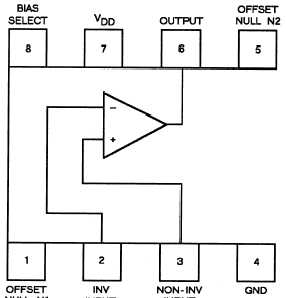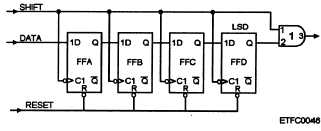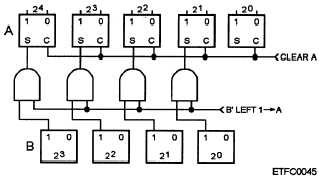Figure 4-28.—Example of a single-line parallel displaced
transfer.
Displaced —Displaced is also similar to the
single-line parallel transfer except the set side outputs
of the sending register are gated to the set side inputs of
the receiving register one or more orders to the right or
left. Refer to figure 4-28 as an example of a displaced
transfer.
Shift Registers.—A shift register has the ability to
store information the same as the storage register;
however it is designed to do more than just store
information. A shift register is even more versatile than
a storage register.
The shift register is capable of
receiving, rearranging, and retaining binary data that
can be extracted for later use in the computer. It can
receive information either in serial or parallel form, and
information may be extracted in either serial or parallel
form. When the information is extracted in serial form,
it may be shifted to the right or left. The shifting is
useful in many operations, such as multiplication,
division, comparing binary bits, and sequencing a series
of events. Remember, shift registers handle both serial
and parallel information. Specifically, information can
be moved in the following ways:
Serial in-serial out right shift
Serial in-parallel out left shift
Parallel in-serial out left shift
Parallel in-serial out right shift
Figure 4-29 shows an example of a serial in-serial
out right Shift.
TOPIC 5—LINEAR IC’S
Linear circuits are amplifying-type circuits in
integrated form. The term linear is simply another way
Figure 4-29.—Example of a serial in-serial out right shift
register.
of expressing the concept of regulating as opposed to
switching, found in digital ICs. The output of a linear
circuit changes in a smooth, even manner as the input
is changed at a constant rate, so that a graph of output
versus input is approximately a straight line; hence, the
name linear. In contrast, the output of digital ICs jumps
suddenly from one level to another.
LINEAR IC FAMILY TYPES
Linear ICs use bipolar and/or MOS technology.
Among the different types of linear ICs you may
encounter are the following:
Bipolar
BIFET—A combination of bipolar and junction
field-effect transistor (JFET) technology
Figure 4-30.—Example of a Lin CMOS—Silicon gate
MOSFET.
4-18







